Table of Contents
1. Introduction
Differentiation is the process where you find the rate of change of a function. The rate of change is sometimes also referred to as the gradient or the tangent, but in differentiation we call the rate of change the “derivative“. This is the gradient of a single point on a graph. The symbol for a derivative is “dy⁄dx“.
Legend
Δ (delta) = Change
∠ = Angle
≈ = Approximately equal to
dy⁄dx = Derivative
2. Linear graphs
With a linear graph (which is just a straight line) it is easier to find the gradient then when we have a non-linear graph. In the example below we have a linear graph in which we use the tangent to find the gradient.
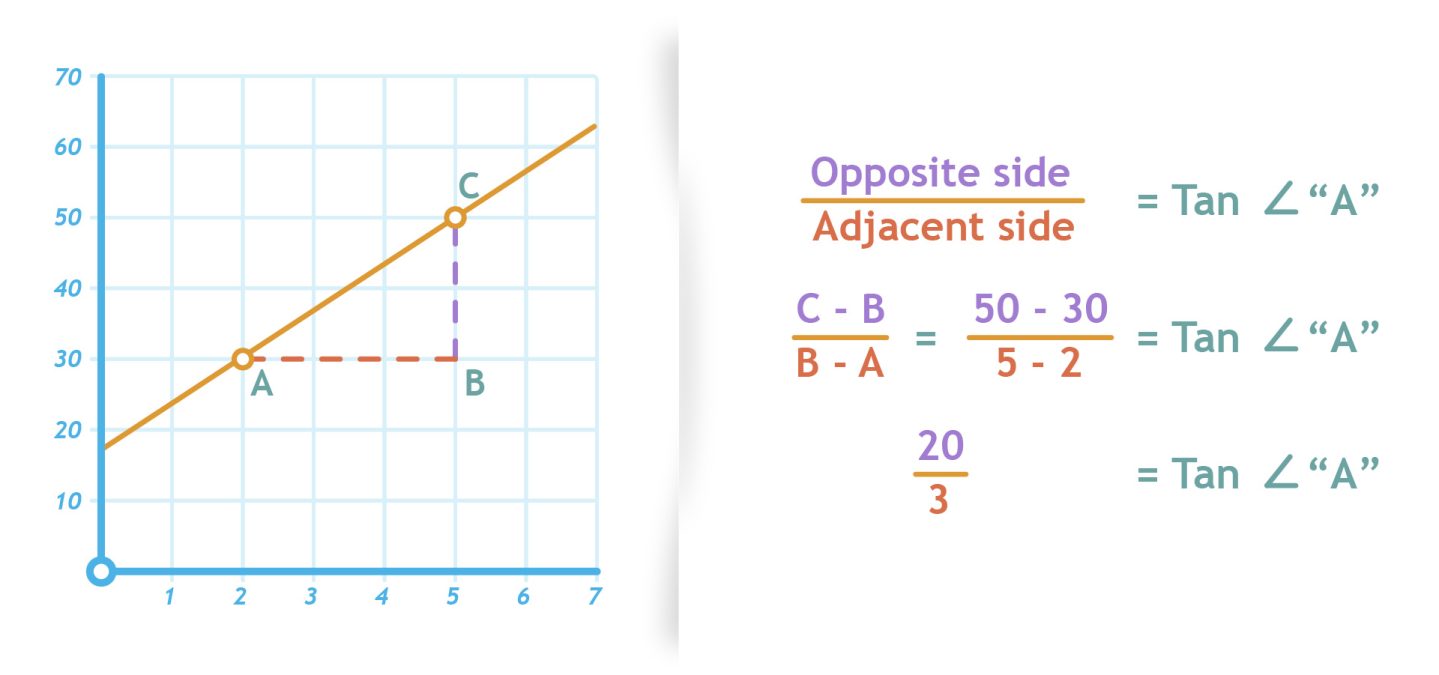
- For a recap on the tangent, visit the post about it here: "Sine, Cosine and Tangent"
- Check if your calculator is set to "degrees" or "radians" depending on the solution needed. You can change this setting by pressing the "mode" button on your calculator until you see "Deg" or "Rad". Select the one you need.
3. dy/dx
To find a gradient, all we need to know are two points on the graph. Divide the “change in y” (opposite side) by the “change in x” (adjacent side) and you get the gradient. That’s also what “dy/dx” stands for. The “d” is short for Δ (delta). Delta means “change”. So “dy” stands for “change in y” and “dx” stands for “change in x”.
4. Non-linear graphs
With a non-linear graph we are going to use the same principle, only in a slightly different way. Because a non-linear graph is curved and not straight, we’ll need to simulate a straight line. We do this by making the adjacent side as small as possible. Basically, we are just zooming in on the graph until it seems like it is a linear graph.
For the non-linear graph below, we have the example function of “f(x)”. The solution of this function gives us the “y” coordinate and the “x” within the function is the “x” coordinate. Because we want the change on the “x” axis to be as small as possible to simulate a linear graph, we make this change as close to zero as possible, something like “0.001”. In the example below this is written as “dx”.
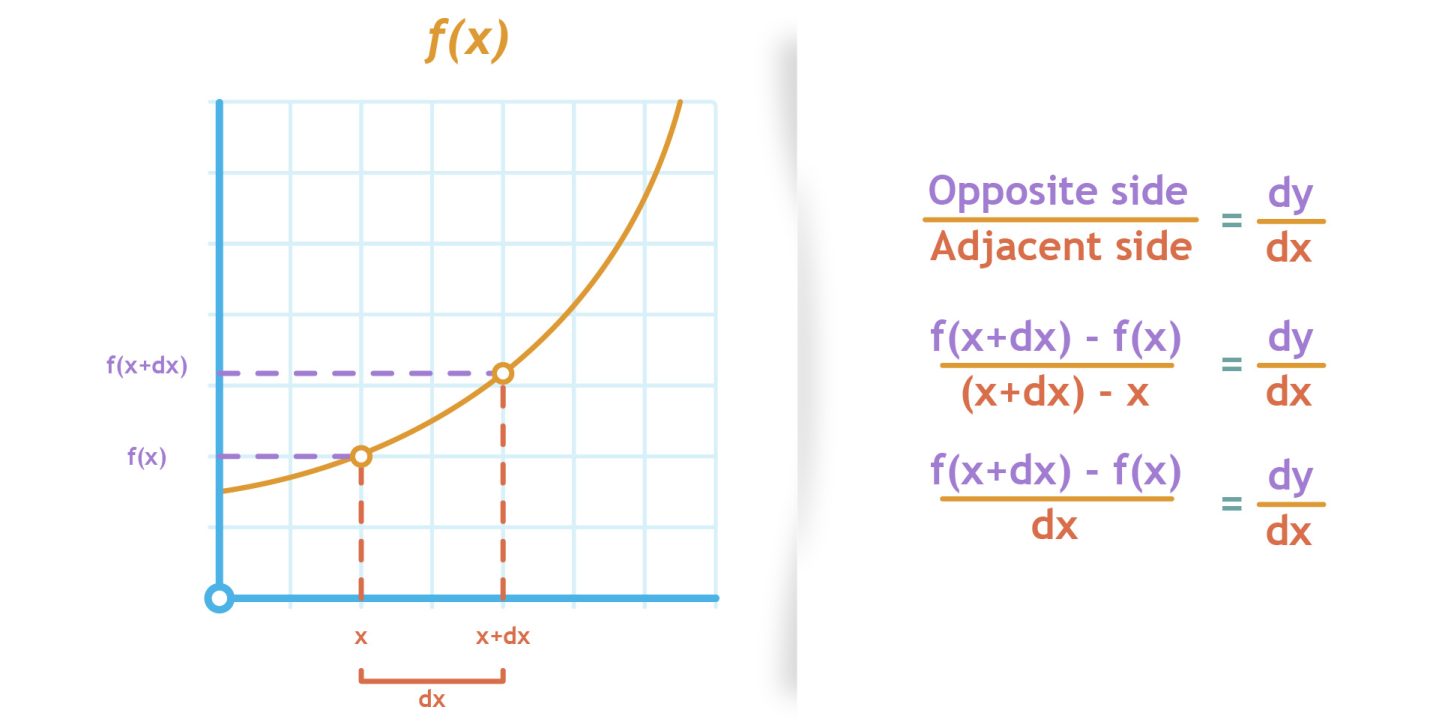
5. Step by step
Step 1: Find the “x” value of the point “A” of which you need the derivative.
Step 2: For the second point “B”, add a change to the “x” value of “A” that is close to “0” e.g. “0.001”.
Step 3: Calculate the “y” coordinates by filling the “x” coordinates in to the function.
Step 4: Calculate “dx” and “dy” with subtraction.
Step 5: Divide “dy” by “dx”.
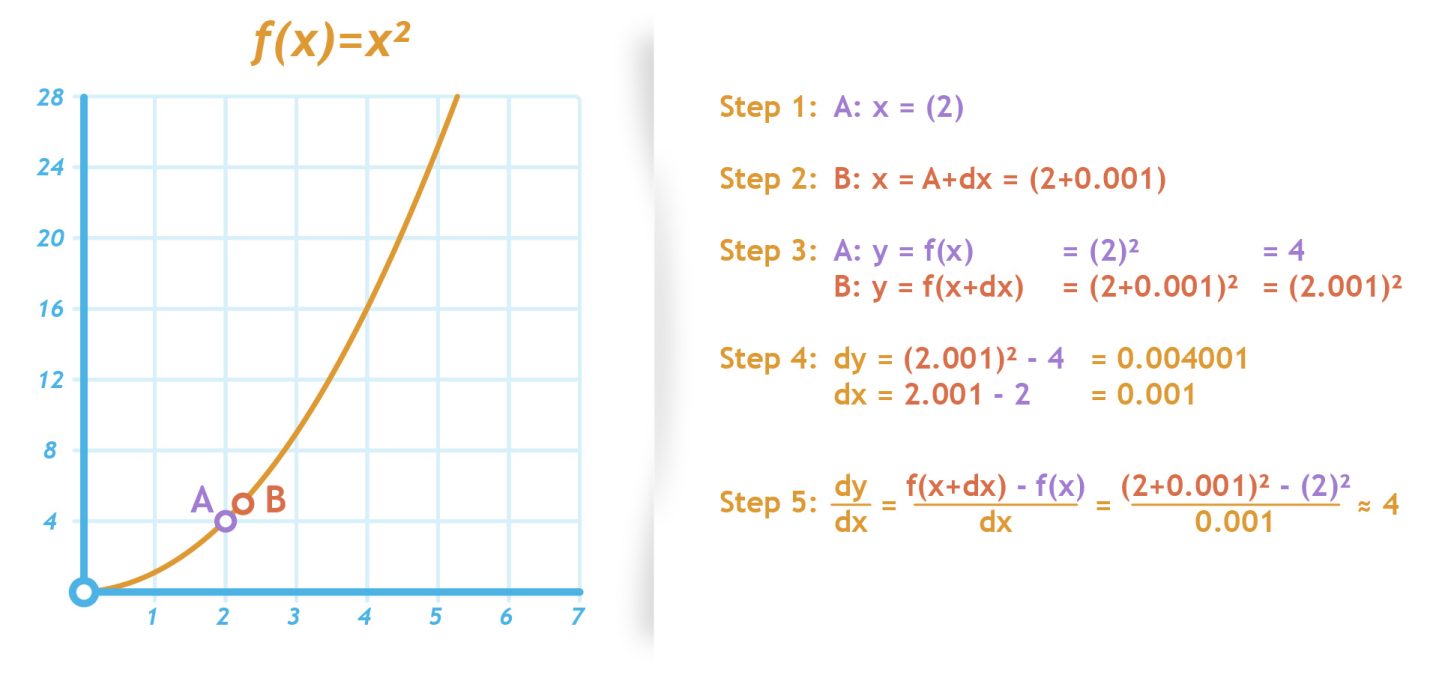
6. Summary
To find the derivative of a function, you have to divide the change in “y” (dy) by the change in “x” (dx).
“dy” is the same as the change in “y”. This is the opposite side.
“dx” is the same as the change in “x”. This is the adjacent side.
“dy/dx” is the same as “opposite side”/”adjacent side”, which is the gradient (tangent).
To simulate a straight line on a non-linear graph, we make “dx” as close to “0” as possible. Basically, we are just zooming in on the graph until it seems like it is a linear graph.
7. Formulas
Tangent of an angle:
Opposite side / Adjacent side = Tangent of an angle
dy/dx:
(f(x+dx) – f(x)) / dx = Derivative
1. Introductie
Differentiëren is het proces waarbij je zoekt hoe snel een functie stijgt of daalt. Dit wordt soms ook wel eens de helling of de tangens genoemd, maar bij differentiëren noemen we dit “de afgeleide“. Dit is de helling van een punt op een grafiek. Het symbool dat hierbij hoort is “dy⁄dx“.
Legenda
Δ (delta) = Verschil
∠ = Hoek
≈ = Ongeveer gelijk aan
dy⁄dx = De afgeleide
2. lineaire grafieken
Met een lineaire grafiek (wat gewoon een rechte lijn is) is het makkelijker om de helling te vinden dan wanneer we een niet-lineaire grafiek hebben. In het voorbeeld hieronder hebben we een lineaire grafiek in welke we de tangens gebruiken om de helling te bepalen.
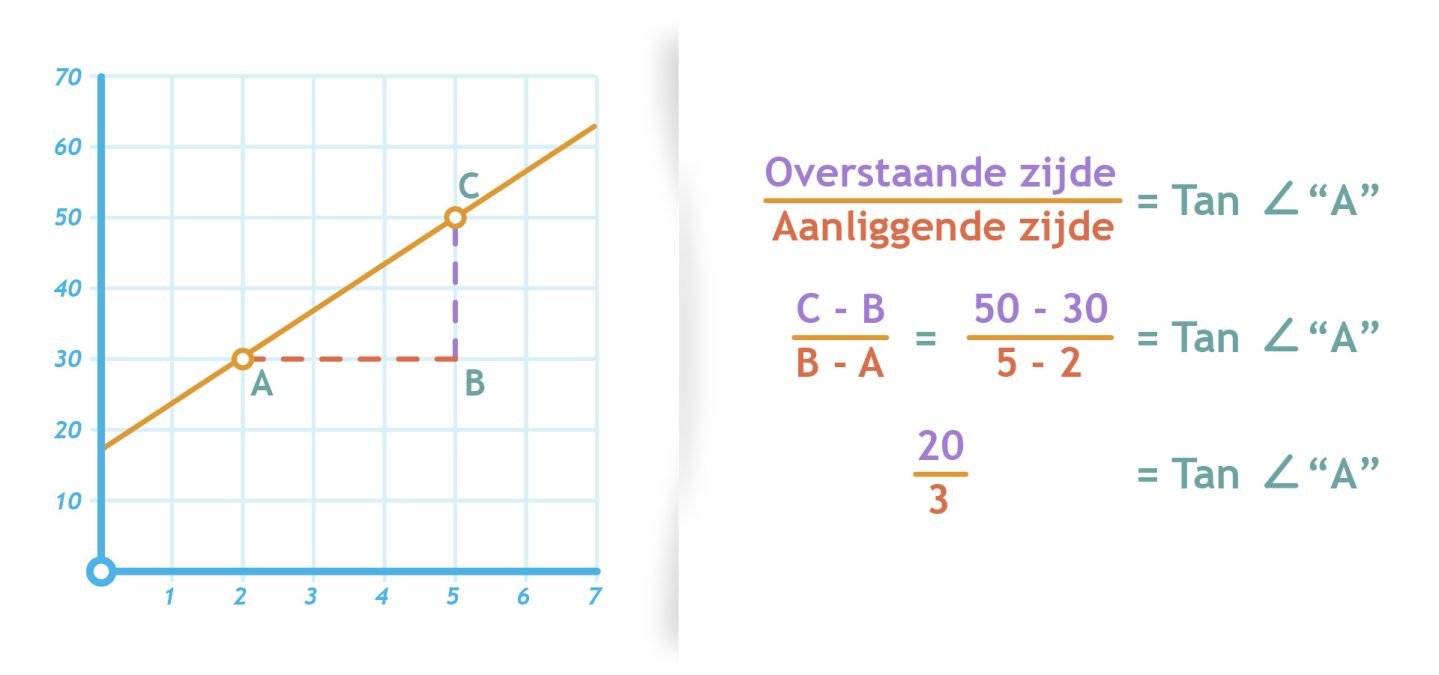
- Voor een herhaling over de tangens, kun je deze post lezen: "Sinus, Cosinus en Tangens"
- Check of je rekenmachine op "graden" of "radialen" is ingesteld afhankelijk wat voor de uitkomst nodig is. Je kunt dit aanpassen door op de "mode" knop op je rekenmachine te drukken totdat je "Deg" of "Rad" ziet staan. Selecteer de optie die je nodig hebt.
3. dy/dx
Om de helling te vinden, hoeven we alleen maar twee punten op de grafiek te weten. Deel het “verschil van y” (overstaande zijde) door het “verschil van x” (aanliggende zijde), en je krijgt de helling van de hoek. Dit is ook waar “dy/dx” voor staat. De “d” is afgekort voor Δ (delta). Delta betekend “verschil”. Dus “dy” staat eigenlijk voor “verschil van y” en “dx” staat voor “verschil van x”.
4. Niet-lineaire grafieken
Met een niet-lineaire grafiek gebruiken we hetzelfde principe, alleen op een beetje andere manier. Omdat een niet-lineaire grafiek niet een rechte lijn is, moete we deze zelf maken. We doen dit door de aanliggende zijde zo klein mogelijk te maken. Eigenlijk zoemen we heel ver in op de grafiek totdat het lijkt alsof de grafiek lineair is.
Voor de niet-lineaire grafiek hieronder, hebben we de voorbeeldfunctie van “f(x)”. De oplossing van deze functie geeft on de “y” coördinaat en de “x” in de functie is de “x” coördinaat. Omdat we het verschil op de “x” as zo klein mogelijk willen houden om het een lineaire grafiek te laten lijken, maken we dit verschil zo dicht mogelijk bij nul, iets als “0,001”. In het voorbeeld hieronder is dit geschreven als “dx”.
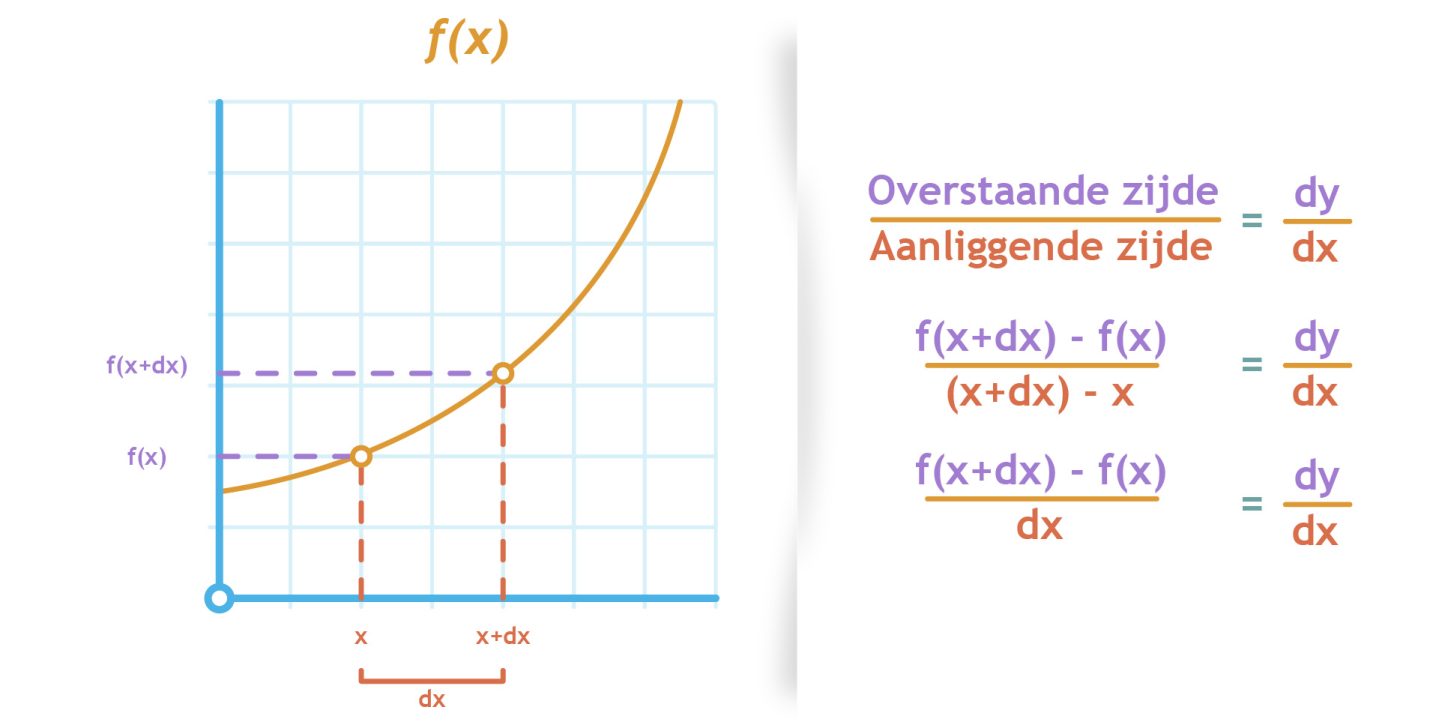
5. Stap voor stap
Stap 1: Vind de “x” waarde voor het punt “A” van welke je de afgeleide waarde wil berekenen.
Stap 2: Voor het tweede punt “B”, tel je bij “A” een verschil op dat dicht bij “0” ligt. Bijv. “0,001”.
Stap 3: Bereken de “y” coördinaten door de “x” coördinaten in de functie in te vullen.
Stap 4: Bereken “dy” en “dx” door het verschil te berekenen.
Stap 5: Deel “dy” door “dx”.

6. Samenvatting
Om de afgeleide van een functie te vinden, moet je het verschil in “y” (dy) delen door het verschil in “x” (dx).
“dy” is hetzelfde als het verschil in “y”. Dit is de overstaande zijde.
“dx” is hetzelfde als het verschil in “x”. Dit is de aanliggende zijde.
“dy/dx” is hetzelfde als “overstaande zijde”/”aanliggende zijde”, wat de helling is (tangens).
Om een non-lineaire lijn toch als een lineaire lijn te laten lijken, maken we “dx” zo dicht mogelijk bij “0”. Eigenlijk zoemen we heel ver in op de grafiek totdat het lijkt alsof de grafiek lineair is.
7. Formules
Tangens van een hoek:
Overstaande zijde / Aanliggende zijde = Tangens van een hoek
dy/dx:
(f(x+dx) – f(x)) / dx = De afgeleide
This Post Has 2 Comments
- Emahnee Cover February 19, 2020 Reply
awesome and simple explanation!
- Sugma Hawk January 29, 2022 Reply
awesome and simple explanation!


This Post Has 2 Comments
awesome and simple explanation!
awesome and simple explanation!